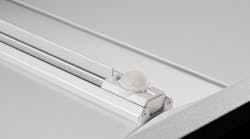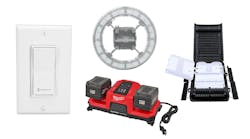The lighting industry has successfully managed the evolution from legacy to LED sources over a little more than a dozen years. This transition has brought with it a myriad of control opportunities that were not possible in lighting applications using fluorescent or high-intensity discharge (HID) lamps. Solid-state technologies allow us to continuously dim, tune color spectrum, and add numerous control strategies to lighting systems through controllers and sensors. All these technology opportunities were recognized during the LED revolution and have been in development and application for up to 10 years.
One such lighting system option is luminaire level lighting controls (LLLCs). LLLC technology is a subset of networked lighting control (NLC) systems that includes factory-integrated sensors in each luminaire. These sensors provide occupancy and daylight sensing and wireless, two-way digital communication with (at a minimum) other luminaires in the space, or (at the maximum) broader connectivity via a gateway and the internet, to unite remote spaces such as those found on an educational campus.
As a critical enabler of many advanced NLC capabilities, LLLC is a valuable tool. Without it, granular sensing to support systems integration, flexibility, and personalization is not possible. The Internet of Things (IoT) relies on it for smart building sensing, communication, and integration. It can also provide an efficient out-of-the-box installation experience. So, how has the development and introduction of LLLC progressed to date?
Early on, there were some challenges to overcome, as expected of a rapidly evolving technology. With this development, lessons are learned along the way. One such challenge led the industry to identify the importance of driver-to-controller compatibility in support of maintaining dimming characteristics, especially when the sensor/controllers were matched with another company’s luminaire driver. Now, manufacturers provide lists of compatible components, and in the future, we’ll surely see some standards written to avoid this challenge altogether.
Another hurdle was confusing programming or configuration of luminaire assignments, groupings, and/or settings within the programming steps. LLLC configuration apps are continually improving, adapting to the newest technology norms and are thereby vastly more user-friendly than the first-generation lighting controls of 10 years ago. Installers are evolving as well, becoming familiar with programming and wireless connectivity. Manufacturers have also added code-adherent dim level and timeout presets to simplify installation even further.
In some cases, LLLC installation annoyances had little to do with lighting: One manufacturer initially made its configuration app downloadable only to Android devices, frustrating iPhone users. Other LLLC systems using an internet connection had to learn to maintain that connection — and, when loss of internet connection happened, user configuration settings had to be reset. These and other early challenges have now largely been resolved across all manufacturers.
These necessary developments are not an indication of poor engineering or faulty manufacturing; they are merely part of a rapidly growing industry effort to facilitate a connected building environment, which must last for decades and potentially interface with older technology and other building systems. This presents quite a challenge, like the transition to LED itself — one that the lighting industry is rapidly evolving to achieve.
To meet the demand for these products, networked controls manufacturers have invested heavily in software, security, and programming expertise; expanded research and development; and implemented accelerated lifetime testing and generations of products to reach reliability. Most LLLC manufacturers are offering five- to 10-year warranties on their systems, an acknowledgment to long-term commitment and a detail to look for when choosing a system.
It’s no wonder they’re making the commitment: LLLC applications are very popular in retrofit applications, providing an integrated control option that meets or exceeds local codes through factory default settings, and installs by simply making a power connection regardless of existing physical wiring and switching constraints. Typical concerns of stand-alone controls and installing area sensors and grouping are overcome through the wireless devices and programming apps.
LLLC opportunities are expanding to include advanced capabilities, including things such as humidity, temperature and sound detection, along with facilitating overall connectivity. Color-changing and spectral tuning are also growing in availability.
These are motivating a collaborative effort not only by control and luminaire manufacturers, but in concert with organizations like ANSI, DOE-SSL, IECC, NEMA, the DesignLights Consortium, and the Illuminating Engineering Society, all to standardize methods for efficiency, persistency, and cost-effectiveness in the development and further market adoption of LLLC.
Tony Adams is an international lighting industry speaker and instructor. He can be reached at [email protected].




